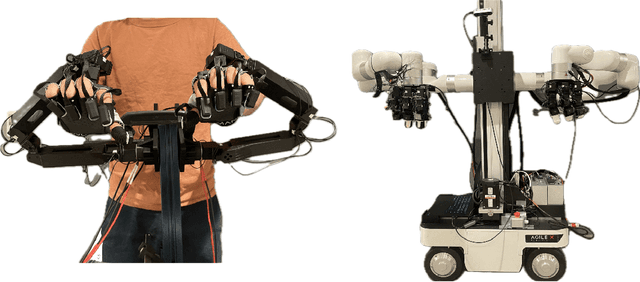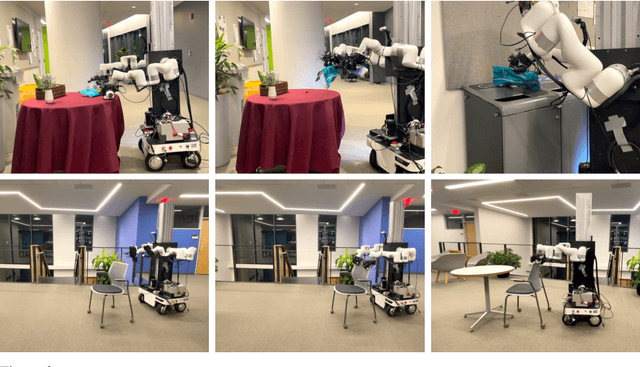Jiahui Yang
BTL-UI: Blink-Think-Link Reasoning Model for GUI Agent
Sep 19, 2025Abstract:In the field of AI-driven human-GUI interaction automation, while rapid advances in multimodal large language models and reinforcement fine-tuning techniques have yielded remarkable progress, a fundamental challenge persists: their interaction logic significantly deviates from natural human-GUI communication patterns. To fill this gap, we propose "Blink-Think-Link" (BTL), a brain-inspired framework for human-GUI interaction that mimics the human cognitive process between users and graphical interfaces. The system decomposes interactions into three biologically plausible phases: (1) Blink - rapid detection and attention to relevant screen areas, analogous to saccadic eye movements; (2) Think - higher-level reasoning and decision-making, mirroring cognitive planning; and (3) Link - generation of executable commands for precise motor control, emulating human action selection mechanisms. Additionally, we introduce two key technical innovations for the BTL framework: (1) Blink Data Generation - an automated annotation pipeline specifically optimized for blink data, and (2) BTL Reward -- the first rule-based reward mechanism that enables reinforcement learning driven by both process and outcome. Building upon this framework, we develop a GUI agent model named BTL-UI, which demonstrates consistent state-of-the-art performance across both static GUI understanding and dynamic interaction tasks in comprehensive benchmarks. These results provide conclusive empirical validation of the framework's efficacy in developing advanced GUI Agents.
Deep Reactive Policy: Learning Reactive Manipulator Motion Planning for Dynamic Environments
Sep 08, 2025Abstract:Generating collision-free motion in dynamic, partially observable environments is a fundamental challenge for robotic manipulators. Classical motion planners can compute globally optimal trajectories but require full environment knowledge and are typically too slow for dynamic scenes. Neural motion policies offer a promising alternative by operating in closed-loop directly on raw sensory inputs but often struggle to generalize in complex or dynamic settings. We propose Deep Reactive Policy (DRP), a visuo-motor neural motion policy designed for reactive motion generation in diverse dynamic environments, operating directly on point cloud sensory input. At its core is IMPACT, a transformer-based neural motion policy pretrained on 10 million generated expert trajectories across diverse simulation scenarios. We further improve IMPACT's static obstacle avoidance through iterative student-teacher finetuning. We additionally enhance the policy's dynamic obstacle avoidance at inference time using DCP-RMP, a locally reactive goal-proposal module. We evaluate DRP on challenging tasks featuring cluttered scenes, dynamic moving obstacles, and goal obstructions. DRP achieves strong generalization, outperforming prior classical and neural methods in success rate across both simulated and real-world settings. Video results and code available at https://deep-reactive-policy.com
UniCP: A Unified Caching and Pruning Framework for Efficient Video Generation
Feb 06, 2025



Abstract:Diffusion Transformers (DiT) excel in video generation but encounter significant computational challenges due to the quadratic complexity of attention. Notably, attention differences between adjacent diffusion steps follow a U-shaped pattern. Current methods leverage this property by caching attention blocks, however, they still struggle with sudden error spikes and large discrepancies. To address these issues, we propose UniCP a unified caching and pruning framework for efficient video generation. UniCP optimizes both temporal and spatial dimensions through. Error Aware Dynamic Cache Window (EDCW): Dynamically adjusts cache window sizes for different blocks at various timesteps, adapting to abrupt error changes. PCA based Slicing (PCAS) and Dynamic Weight Shift (DWS): PCAS prunes redundant attention components, and DWS integrates caching and pruning by enabling dynamic switching between pruned and cached outputs. By adjusting cache windows and pruning redundant components, UniCP enhances computational efficiency and maintains video detail fidelity. Experimental results show that UniCP outperforms existing methods in both performance and efficiency.
MoEE: Mixture of Emotion Experts for Audio-Driven Portrait Animation
Jan 03, 2025



Abstract:The generation of talking avatars has achieved significant advancements in precise audio synchronization. However, crafting lifelike talking head videos requires capturing a broad spectrum of emotions and subtle facial expressions. Current methods face fundamental challenges: a)the absence of frameworks for modeling single basic emotional expressions, which restricts the generation of complex emotions such as compound emotions; b)the lack of comprehensive datasets rich in human emotional expressions, which limits the potential of models. To address these challenges, we propose the following innovations: 1)the Mixture of Emotion Experts (MoEE) model, which decouples six fundamental emotions to enable the precise synthesis of both singular and compound emotional states; 2)the DH-FaceEmoVid-150 dataset, specifically curated to include six prevalent human emotional expressions as well as four types of compound emotions, thereby expanding the training potential of emotion-driven models. Furthermore, to enhance the flexibility of emotion control, we propose an emotion-to-latents module that leverages multimodal inputs, aligning diverse control signals-such as audio, text, and labels-to ensure more varied control inputs as well as the ability to control emotions using audio alone. Through extensive quantitative and qualitative evaluations, we demonstrate that the MoEE framework, in conjunction with the DH-FaceEmoVid-150 dataset, excels in generating complex emotional expressions and nuanced facial details, setting a new benchmark in the field. These datasets will be publicly released.
Bimanual Dexterity for Complex Tasks
Nov 20, 2024



Abstract:To train generalist robot policies, machine learning methods often require a substantial amount of expert human teleoperation data. An ideal robot for humans collecting data is one that closely mimics them: bimanual arms and dexterous hands. However, creating such a bimanual teleoperation system with over 50 DoF is a significant challenge. To address this, we introduce Bidex, an extremely dexterous, low-cost, low-latency and portable bimanual dexterous teleoperation system which relies on motion capture gloves and teacher arms. We compare Bidex to a Vision Pro teleoperation system and a SteamVR system and find Bidex to produce better quality data for more complex tasks at a faster rate. Additionally, we show Bidex operating a mobile bimanual robot for in the wild tasks. The robot hands (5k USD) and teleoperation system (7k USD) is readily reproducible and can be used on many robot arms including two xArms (16k USD). Website at https://bidex-teleop.github.io/
Neural MP: A Generalist Neural Motion Planner
Sep 09, 2024Abstract:The current paradigm for motion planning generates solutions from scratch for every new problem, which consumes significant amounts of time and computational resources. For complex, cluttered scenes, motion planning approaches can often take minutes to produce a solution, while humans are able to accurately and safely reach any goal in seconds by leveraging their prior experience. We seek to do the same by applying data-driven learning at scale to the problem of motion planning. Our approach builds a large number of complex scenes in simulation, collects expert data from a motion planner, then distills it into a reactive generalist policy. We then combine this with lightweight optimization to obtain a safe path for real world deployment. We perform a thorough evaluation of our method on 64 motion planning tasks across four diverse environments with randomized poses, scenes and obstacles, in the real world, demonstrating an improvement of 23%, 17% and 79% motion planning success rate over state of the art sampling, optimization and learning based planning methods. Video results available at mihdalal.github.io/neuralmotionplanner
Hyper-3DG: Text-to-3D Gaussian Generation via Hypergraph
Mar 14, 2024



Abstract:Text-to-3D generation represents an exciting field that has seen rapid advancements, facilitating the transformation of textual descriptions into detailed 3D models. However, current progress often neglects the intricate high-order correlation of geometry and texture within 3D objects, leading to challenges such as over-smoothness, over-saturation and the Janus problem. In this work, we propose a method named ``3D Gaussian Generation via Hypergraph (Hyper-3DG)'', designed to capture the sophisticated high-order correlations present within 3D objects. Our framework is anchored by a well-established mainflow and an essential module, named ``Geometry and Texture Hypergraph Refiner (HGRefiner)''. This module not only refines the representation of 3D Gaussians but also accelerates the update process of these 3D Gaussians by conducting the Patch-3DGS Hypergraph Learning on both explicit attributes and latent visual features. Our framework allows for the production of finely generated 3D objects within a cohesive optimization, effectively circumventing degradation. Extensive experimentation has shown that our proposed method significantly enhances the quality of 3D generation while incurring no additional computational overhead for the underlying framework. (Project code: https://github.com/yjhboy/Hyper3DG)
Boundary-Aware Proposal Generation Method for Temporal Action Localization
Sep 25, 2023



Abstract:The goal of Temporal Action Localization (TAL) is to find the categories and temporal boundaries of actions in an untrimmed video. Most TAL methods rely heavily on action recognition models that are sensitive to action labels rather than temporal boundaries. More importantly, few works consider the background frames that are similar to action frames in pixels but dissimilar in semantics, which also leads to inaccurate temporal boundaries. To address the challenge above, we propose a Boundary-Aware Proposal Generation (BAPG) method with contrastive learning. Specifically, we define the above background frames as hard negative samples. Contrastive learning with hard negative mining is introduced to improve the discrimination of BAPG. BAPG is independent of the existing TAL network architecture, so it can be applied plug-and-play to mainstream TAL models. Extensive experimental results on THUMOS14 and ActivityNet-1.3 demonstrate that BAPG can significantly improve the performance of TAL.
Coordinated Defense Allocation in Reach-Avoid Scenarios with Efficient Online Optimization
Apr 01, 2023



Abstract:Deriving strategies for multiple agents under adversarial scenarios poses a significant challenge in attaining both optimality and efficiency. In this paper, we propose an efficient defense strategy for cooperative defense against a group of attackers in a convex environment. The defenders aim to minimize the total number of attackers that successfully enter the target set without prior knowledge of the attacker's strategy. Our approach involves a two-scale method that decomposes the problem into coordination against a single attacker and assigning defenders to attackers. We first develop a coordination strategy for multiple defenders against a single attacker, implementing online convex programming. This results in the maximum defense-winning region of initial joint states from which the defender can successfully defend against a single attacker. We then propose an allocation algorithm that significantly reduces computational effort required to solve the induced integer linear programming problem. The allocation guarantees defense performance enhancement as the game progresses. We perform various simulations to verify the efficiency of our algorithm compared to the state-of-the-art approaches, including the one using the Gazabo platform with Robot Operating System.
Online Metric Learning for Multi-Label Classification
Jun 12, 2020



Abstract:Existing research into online multi-label classification, such as online sequential multi-label extreme learning machine (OSML-ELM) and stochastic gradient descent (SGD), has achieved promising performance. However, these works do not take label dependencies into consideration and lack a theoretical analysis of loss functions. Accordingly, we propose a novel online metric learning paradigm for multi-label classification to fill the current research gap. Generally, we first propose a new metric for multi-label classification which is based on $k$-Nearest Neighbour ($k$NN) and combined with large margin principle. Then, we adapt it to the online settting to derive our model which deals with massive volume ofstreaming data at a higher speed online. Specifically, in order to learn the new $k$NN-based metric, we first project instances in the training dataset into the label space, which make it possible for the comparisons of instances and labels in the same dimension. After that, we project both of them into a new lower dimension space simultaneously, which enables us to extract the structure of dependencies between instances and labels. Finally, we leverage the large margin and $k$NN principle to learn the metric with an efficient optimization algorithm. Moreover, we provide theoretical analysis on the upper bound of the cumulative loss for our method. Comprehensive experiments on a number of benchmark multi-label datasets validate our theoretical approach and illustrate that our proposed online metric learning (OML) algorithm outperforms state-of-the-art methods.
 Add to Chrome
Add to Chrome Add to Firefox
Add to Firefox Add to Edge
Add to Edge